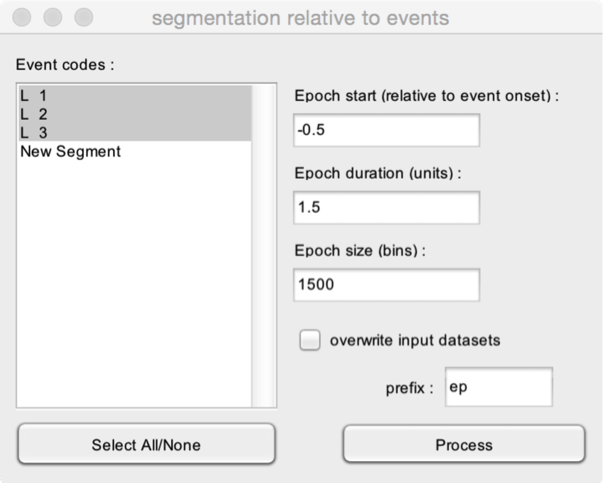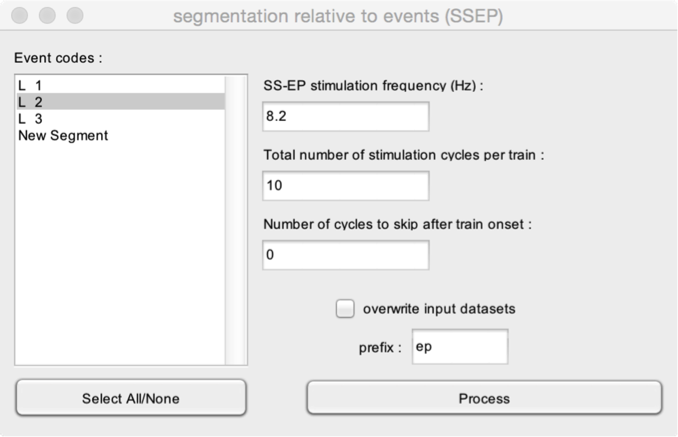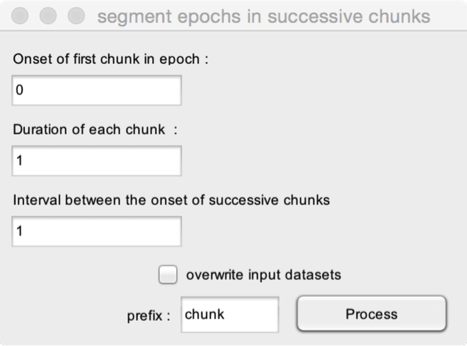-
Notifications
You must be signed in to change notification settings - Fork 30
Segmentation
Segmentation functions are used to segment continuous recordings into a series of epochs of a given length.
- Segmentation relative to events
- Segmentation relative to events (one file per event code)
- Segmentation relative to events (SS-EPs)
- Segment epochs in successive chunks (SS-EPs)
Segment a continuous dataset into a series of epochs of a given length, relative to the latencies of events.

- Event codes. Choose the event codes to include. Epochs will be segmented relative to all events having matching event codes. If you select more than one event code, the output will be a single dataset including all epochs occurring around the selected event codes.
- Epoch start. The time of the first sample of each epoch, expressed relative to the event onset.
- Epoch duration. The duration of each epoch.
- Epoch size. The number of samples in each epoch. This value is dependent on the samplingrate and epoch duration.
In this example, the continuous dataset has 30 events corresponding to ‘L 1’, 30 events corresponding to ‘L 2’ and 30 events corresponding to ‘L 3’. The output dataset will thus have a total of 90 epochs (30 epochs with L_1, 30 epochs with L_2 and 30 epochs with L_3). Each epoch will have 1500 samples, extending from -0.5 s to +1 s relative to the onset of each event.
Segment a continuous dataset into a series of epochs of a given length, relative to the latencies of events. If multiple event codes are selected, the function will generate a separate dataset for each event code. This is useful if different event codes are used to identify different experimental conditions.

- Event codes. Choose the event codes to include. Epochs will be segmented relative to all events having matching event codes. If you select more than one event code, the output will be multiple datasets: one dataset including all epochs occurring around each selected event code).
- Epoch start. The time of the first sample of each epoch, expressed relative to the event onset.
- Epoch duration. The duration of each epoch.
- Epoch size. The number of samples in each epoch. This value is dependent on the samplingrate and epoch duration.
In this example, the continuous dataset has 30 events corresponding to ‘L 1’, 30 events corresponding to ‘L 2’ and 30 events corresponding to ‘L 3’. The output will be three datasets, each having 30 epochs. Each epoch will have 1500 samples, extending from -0.5 s to +1 s relative to the onset of each event.
This function is used to segment continuous data. It is specifically designed to segment data obtained in experiments recording steady-state evoked potentials (SS-EPs).

- Event codes. Choose the event codes to include. Epochs will be segmented relative to all events having matching event codes. If you select more than one event code, the output will be multiple datasets: one dataset including all epochs occurring around each selected event code).
- SS-EP stimulation frequency. The frequency of SS-EP stimulation.
- Total number of stimulation cycles per train. The number of times the stimulus is repeated in each stimulation train.
- Number of cycles to skip after train onset. In some experiments, it is interesting to discard the signal recorded during the first cycles of the stimulation train, such as to avoid a contribution of activity related to the train onset. This field allows removing these initial cycles.
In this example, a visual stimulus is flashed at a frequency of 8.2 Hz. The total number of repetitions is 10. Hence, a train of stimulation lasts 10/8.2=1.22 s. Because we have chosen to not exclude initial cycles, the function will segment the data into epochs extending between 0 and 1.22 s relative to the onsets of event L_2.
This function is used to segment epochs into successive chunks of data. This is useful to segment EEG epochs during which a stimulus is repeated periodically (steady-state evoked potentials) into epochs circumscribing each event of a train.

- Onset of first chunk in epoch. The latency of the first repeated event in the epoch. For example, if the train starts at latency = 0 s, the onset of the first chunk in the epoch should be set to 0 s.
- Duration of each chunk. The duration of each chunk. For example, if your stimulus is repeated periodically at a frequency of 1 Hz, you may want to cut the epoch into chunks lasting 1 s.
- Interval between the onset of successive chunks. The time interval between two events in the train. For example, if your stimulus is repeated periodically at a frequency of 1 Hz, you will want to set the time interval to 1 s.
Plugins
User interface
File
Edit
Events
- Browse and edit events
- Delete duplicate events
- Create events from level trigger
- Merge event codes and latencies
Pre-processing
- DC removal and linear detrend
- Reference
- Frequency filters
- Spatial filters (ICA)
- Epoch segmentation
- Baseline operations
- Artefact rejection and suppression
- Current source density (CSD)
- Frequency and time-frequency transforms
- Time-frequency filters
- Resample signals
- Resample signals
- Arrange signals
Post-processing
- Average
- Single-trial analysis
- Math
- Source analysis (dipole fitting)
- Find peaks in waveforms
- Global explained variance
Statistics
- Compare datasets against a constant
- Compare two datasets
- Compare more than two datasets (ANOVA)
- Compare signal amplitude at event latencies
- Bootstrap test against a reference interval
Figures